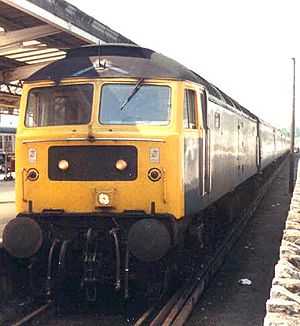British Rail Class 48 facts for kids
Quick facts for kids Brush Type 4British Rail Class 48 |
|
 |
|
| Former Class 48, No.47117, at Weymouth station with a holiday passenger train in 1989. | |
| Power type | Diesel-electric |
|---|---|
| Builder | Brush Traction, Falcon Works |
| Build date | 1965–1966 |
| Total production | 5 |
| Configuration | Co-Co |
| UIC classification | Co'Co' |
| Wheel diameter | 3 ft 9 in (1.143 m) |
| Wheelbase | 51 ft 6 in (15.70 m) |
| Length | 63 ft 6 in (19.35 m) |
| Width | 8 ft 10 in (2.69 m) |
| Height | 12 ft 9+3⁄8 in (3.90 m) |
| Locomotive weight | 112 long tons (114 t) |
| Prime mover | Sulzer 12LVA24 |
| Multiple working | Not fitted |
| Top speed | 95 mph (153 km/h) |
| Power output | Engine: 2,650 bhp (1,976 kW) |
| Train heating | Steam generator |
| Locomotive brakeforce | 60 long tons-force (598 kN) |
| Train brakes | Vacuum |
| Career | British Rail |
| Number | D1702–D1706 |
| Axle load class | Route availability 7 (RA 6 from 1969) |
| Disposition | Re-engined to Class 47, 1969–1971 |
The British Rail Class 48 was a special type of diesel train engine used in Britain. Only five of these powerful engines were ever built. They were made by a company called Brush at their factory in Loughborough between 1965 and 1966. These engines looked a lot like the more common Class 47 trains, but they had a different kind of engine inside. Instead of the usual engine, the Class 48s used a special Sulzer V12 engine that made 2,650 horsepower.
What Was the Class 48?
The Class 48 was a small group of five diesel-electric locomotives. This means they used a diesel engine to power a generator, which then made electricity to drive the wheels. They were built for British Rail, the main railway company in Britain at the time.
A Special Engine
These five locomotives were actually part of a much larger order for the Class 47 trains. The Class 47 was a very successful and common type of train engine. However, the Class 48s were different because they had a special engine. Most Class 47s used a Sulzer 12LDA28C engine. The Class 48s, though, were fitted with a newer, experimental V12 Sulzer 12LVA24 engine. This engine was designed to be more powerful and efficient.
Short Life, Big Change
Even though the Class 48s had a powerful new engine, they didn't stay as Class 48s for very long. Between 1969 and 1971, all five of these special locomotives were changed. Their unique Sulzer V12 engines were removed. They were then fitted with the standard engines used in the Class 47s. After this change, they were officially reclassified as Class 47 locomotives. This meant the Class 48 type no longer existed as a separate class.
Images for kids


